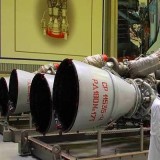How Rampage Missiles Transform the Indian Navy’s MiG-29Ks into Precision Weapons

{loadposition bannertop}
{loadposition sidebarpub}
According to a report published by India Today on January 26, 2025, the Indian Navy has officially integrated the Israeli Rampage air-to-surface missile into its MiG-29K fighter jets, marking a step in enhancing its aerial capabilities. This strategic development aligns with India’s efforts to strengthen its defense capabilities in response to increasing regional security challenges while reinforcing its long-standing technological partnership with Israel.
Follow Army Recognition on Google News at this link
In April 2024, the missile was also integrated into the Indian Air Force’s fleet, including Sukhoi Su-30MKIs, Jaguars, and MiG-29s (Picture source: X Channel @manjeetnegilive )
The Rampage missile, with an operational range of 250 kilometers and supersonic speed, provides advanced strike capabilities that allow the engagement of high-value targets while remaining outside the reach of enemy air defense systems. Its integration transforms the MiG-29Ks into modern platforms capable of addressing complex strategic objectives.
Developed by Israel Aerospace Industries (IAI) and IMI Systems, the Rampage is a precision long-range air-to-surface missile designed for strategic strikes. Measuring 4.7 meters in length and equipped with the Range Extension and Smart Tail (REST) kit, it combines performance and operational flexibility. With an accuracy of 10 meters CEP (circular error probable), it can target critical infrastructure such as airbases, command centers, ammunition depots, as well as logistical and communication hubs. Its inertial and GPS-based navigation system, with anti-jamming capabilities, ensures optimal performance under all weather conditions and at any time of day while minimizing collateral damage. Its adaptability to urban environments further underscores its relevance in modern combat scenarios.
The Rampage’s acquisition is not limited to the Indian Navy. In April 2024, the missile was also integrated into the Indian Air Force’s fleet, including Sukhoi Su-30MKIs, Jaguars, and MiG-29s. This cross-service compatibility demonstrates India’s intent to optimize its strike capabilities using a missile that can be deployed across a diverse range of aircraft, regardless of their Western or Russian origins. The missile’s integration requires no significant modifications to avionics systems, making it a cost-effective and practical solution. For the MiG-29Ks, specific adaptations such as new bomb racks and wiring upgrades were implemented to ensure seamless deployment.
Strategically, the Rampage significantly extends the operational range of the MiG-29Ks, which operate primarily from the aircraft carriers INS Vikramaditya and INS Vikrant. The combination of these naval platforms and the precision strike capabilities of the missile enhances India’s ability to deter adversaries while safeguarding its pilots and assets through long-range engagements. This development is particularly relevant in the context of growing tensions in the Indian Ocean and South Asia, where India seeks to counter the influence of regional powers like China and Pakistan. For instance, the increasing presence of China’s navy in the Indian Ocean, along with military infrastructure in neighboring countries, has prompted India to invest in advanced weapon systems like the Rampage.
The Rampage stands out not only for its range and precision but also for its operational versatility. Each aircraft can carry up to four missiles, enabling simultaneous strikes on multiple targets or concentrated salvos on a single objective. This capability provides a tactical advantage, especially in missions to neutralize air defense sites or destroy critical infrastructure. Furthermore, the missile’s ability to function in electronic warfare conditions, thanks to its anti-jamming systems, enhances its reliability in contested environments.
India and Israel share a long history of defense cooperation, and the integration of the Rampage highlights the importance of these strategic partnerships. By acquiring advanced technologies from Israel, India not only modernizes its military capabilities but also diversifies its sources of defense procurement, reducing reliance on major global powers. The Rampage exemplifies this approach by combining proven Israeli technology with India’s operational needs.
The integration of the Rampage missile into the Indian Navy’s MiG-29Ks represents a major enhancement in India’s precision strike capabilities. It underscores the country’s commitment to staying at the forefront of military technology and its ability to address strategic challenges in an increasingly complex regional environment. By investing in systems like the Rampage, India demonstrates its resolve to safeguard its national interests while strengthening strategic alliances with key partners like Israel. This initiative, blending technological innovation and defense strategy, positions India as a critical player in regional security.

{loadposition bannertop}
{loadposition sidebarpub}
According to a report published by India Today on January 26, 2025, the Indian Navy has officially integrated the Israeli Rampage air-to-surface missile into its MiG-29K fighter jets, marking a step in enhancing its aerial capabilities. This strategic development aligns with India’s efforts to strengthen its defense capabilities in response to increasing regional security challenges while reinforcing its long-standing technological partnership with Israel.
In April 2024, the missile was also integrated into the Indian Air Force’s fleet, including Sukhoi Su-30MKIs, Jaguars, and MiG-29s (Picture source: X Channel @manjeetnegilive )
The Rampage missile, with an operational range of 250 kilometers and supersonic speed, provides advanced strike capabilities that allow the engagement of high-value targets while remaining outside the reach of enemy air defense systems. Its integration transforms the MiG-29Ks into modern platforms capable of addressing complex strategic objectives.
Developed by Israel Aerospace Industries (IAI) and IMI Systems, the Rampage is a precision long-range air-to-surface missile designed for strategic strikes. Measuring 4.7 meters in length and equipped with the Range Extension and Smart Tail (REST) kit, it combines performance and operational flexibility. With an accuracy of 10 meters CEP (circular error probable), it can target critical infrastructure such as airbases, command centers, ammunition depots, as well as logistical and communication hubs. Its inertial and GPS-based navigation system, with anti-jamming capabilities, ensures optimal performance under all weather conditions and at any time of day while minimizing collateral damage. Its adaptability to urban environments further underscores its relevance in modern combat scenarios.
The Rampage’s acquisition is not limited to the Indian Navy. In April 2024, the missile was also integrated into the Indian Air Force’s fleet, including Sukhoi Su-30MKIs, Jaguars, and MiG-29s. This cross-service compatibility demonstrates India’s intent to optimize its strike capabilities using a missile that can be deployed across a diverse range of aircraft, regardless of their Western or Russian origins. The missile’s integration requires no significant modifications to avionics systems, making it a cost-effective and practical solution. For the MiG-29Ks, specific adaptations such as new bomb racks and wiring upgrades were implemented to ensure seamless deployment.
Strategically, the Rampage significantly extends the operational range of the MiG-29Ks, which operate primarily from the aircraft carriers INS Vikramaditya and INS Vikrant. The combination of these naval platforms and the precision strike capabilities of the missile enhances India’s ability to deter adversaries while safeguarding its pilots and assets through long-range engagements. This development is particularly relevant in the context of growing tensions in the Indian Ocean and South Asia, where India seeks to counter the influence of regional powers like China and Pakistan. For instance, the increasing presence of China’s navy in the Indian Ocean, along with military infrastructure in neighboring countries, has prompted India to invest in advanced weapon systems like the Rampage.
The Rampage stands out not only for its range and precision but also for its operational versatility. Each aircraft can carry up to four missiles, enabling simultaneous strikes on multiple targets or concentrated salvos on a single objective. This capability provides a tactical advantage, especially in missions to neutralize air defense sites or destroy critical infrastructure. Furthermore, the missile’s ability to function in electronic warfare conditions, thanks to its anti-jamming systems, enhances its reliability in contested environments.
India and Israel share a long history of defense cooperation, and the integration of the Rampage highlights the importance of these strategic partnerships. By acquiring advanced technologies from Israel, India not only modernizes its military capabilities but also diversifies its sources of defense procurement, reducing reliance on major global powers. The Rampage exemplifies this approach by combining proven Israeli technology with India’s operational needs.
The integration of the Rampage missile into the Indian Navy’s MiG-29Ks represents a major enhancement in India’s precision strike capabilities. It underscores the country’s commitment to staying at the forefront of military technology and its ability to address strategic challenges in an increasingly complex regional environment. By investing in systems like the Rampage, India demonstrates its resolve to safeguard its national interests while strengthening strategic alliances with key partners like Israel. This initiative, blending technological innovation and defense strategy, positions India as a critical player in regional security.





